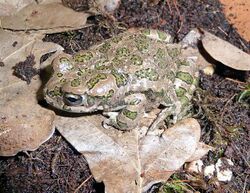Biology:Bufotes pewzowi
| Bufotes pewzowi | |
|---|---|

| |
| Scientific classification | |
| Domain: | Eukaryota |
| Kingdom: | Animalia |
| Phylum: | Chordata |
| Class: | Amphibia |
| Order: | Anura |
| Family: | Bufonidae |
| Genus: | Bufotes |
| Species: | B. pewzowi
|
| Binomial name | |
| Bufotes pewzowi (Bedriaga, 1898)
| |
| Synonyms[2] | |
| |
Bufotes pewzowi is a species of toad in the family Bufonidae. It is found in dry plains of Central Asia, the foothills and mountains of Tian Shan, Zhungar Alatau and Pamir Mountains (Kazakhstan, Kyrgyzstan, Uzbekistan, and Tajikistan), the mountains and deserts of Western China and Mongolia, and probably westward to northern Afghanistan and north to Lake Balkhash in Kazakhstan and northeast Altai Republic in Russia.[2] The specific name pewzowi honours Michail Wassiljewitsch Pewzow, a Russian geographer, cartographer, and explorer.[3] Common names include Xinjiang toad[1] and Pewzow's toad;[2][3] when subspecies B. p. strauchi is recognized, it can be referred to as northern Xinjiang toad, while the nominotypic B. p. pewzowi then becomes southern Xinjiang toad.[2]
Description
Bufotes pewzowi is a tetraploid species that originates from hybridization between Bufotes latastii and Bufotes perrini.[4] Adult males measure 52–77 mm (2.0–3.0 in) and adult females 50–86 mm (2.0–3.4 in) in snout–vent length. Gosner stage 35–37 tadpoles measure about 45 mm (1.8 in) in total length, of which the tail makes almost two thirds.[5]
Habitat and conservation
Bufotes pewzowi occurs in dry steppes, grasslands, semi-deserts and deserts, and in mountains from foothills through all altitudinal belts up to subalpine meadows, perhaps to over 4,000 m (13,000 ft) above sea level. The tadpoles develop in oases, ponds, and pools. It is a very common species that can be found in very disturbed habitat. No major threats to this species are known. It can suffer from extreme habitat modification and from collection for traditional medicine. It probably occurs in several protected areas within its range.[1]
References
- ↑ 1.0 1.1 1.2 Matthias Stöck, Sergius Kuzmin, Fei Liang, Wang Xiuling, Wang Yuezhao (2015). "Bufotes pewzowi". IUCN Red List of Threatened Species 2015: e.T161757A74503748. doi:10.2305/IUCN.UK.2015-1.RLTS.T161757A74503748.en. https://www.iucnredlist.org/species/161757/74503748. Retrieved 16 November 2021.
- ↑ 2.0 2.1 2.2 2.3 Frost, Darrel R. (2020). "Bufotes pewzowi (Bedriaga, 1898)". Amphibian Species of the World: An Online Reference. Version 6.1. American Museum of Natural History. doi:10.5531/db.vz.0001. https://amphibiansoftheworld.amnh.org/Amphibia/Anura/Bufonidae/Bufotes/Bufotes-pewzowi/.
- ↑ 3.0 3.1 Beolens, Bo; Watkins, Michael; Grayson, Michael (2013). The Eponym Dictionary of Amphibians. Pelagic Publishing. p. 167. ISBN 978-1-907807-42-8. https://play.google.com/books/reader?id=QJY3BAAAQBAJ&pg=GBS.PA167.
- ↑ Dufresnes, Christophe; Mazepa, Glib; Jablonski, Daniel; Oliveira, Ricardo Caliari; Wenseleers, Tom; Shabanov, Dmytro A.; Auer, Markus; Ernst, Raffael et al. (2019). "Fifteen shades of green: The evolution of Bufotes toads revisited". Molecular Phylogenetics and Evolution 141: 106615. doi:10.1016/j.ympev.2019.106615. PMID 31520778. https://lirias.kuleuven.be/handle/123456789/643281.
- ↑ "Bufotes pewzowi (Bedriaga, 1898)" (in zh). AmphibiaChina. Kunming Institute of Zoology. 2020. https://www.amphibiachina.org/species/298.
Wikidata ☰ Q1389199 entry
 |


